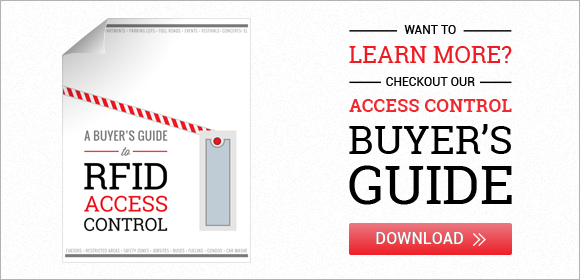Access Control: Letting the Right People In & Keeping the Wrong People Out
Introduction
By using RFID for access control, individuals can feel secure in the fact that the right people have access to a specified area. Below are examples of areas commonly incorporating RFID access control systems.
Building Exteriors
Building access control is essential to businesses, schools, apartments, and any other organization that needs to protect its personnel or property. While there is no automated way to 100% guarantee the wrong people will be kept out, RFID systems can secure facilities very efficiently. The primary problem faced with this system is human nature – people holding doors for others, allowing them access.
RFID Access control systems use LF, HF, and UHF frequencies depending on the type of system. UHF could be used for building access control, but the security level would drop dramatically because of one of the primary reasons UHF tags are so widely used – longer read distances. In the case of building access control, opening a door from 10 to 20 feet away can be a problem. Employees walking around with UHF enabled cards could open doors at various distances, allowing most anyone in.
Installing an LF or HF RFID system building-wide can be a costly process depending on the amount of access points the building contains. Each access point (doors, dock doors) requires a reader which can vary in price from $150 and up depending on whether the reader has other functionalities such as reading both LF and HF frequencies, additional security PIN pads, tamper-proof card identifiers, etc.
Each employee, student, or owner uses an assigned HF or LF key fob or badge to gain access to the building. These key fobs or smartcard badges can run from $1 dollar each for a more basic tag up to $10 - $20 dollars each for a finished product - like an RFID smart card. Once purchased, information can be encoded on them so that the reader will then recognize and enable the system to allow entry.
Parking Lots
Parking lot access control is different from building access control because of the addition of a vehicle. The vehicle adds RF interaction with metal which can cause multipath effects in addition to the increased distance between the tag and reader, calling for a longer read range. LF and HF frequencies are both typically inadequate solutions for parking lot access control because the tag read range is not long enough to reach the reader.
Besides barcodes, UHF RFID is the only automated solution for longer range access control that is used today. Barcodes can be used for access control; however, they must be extremely rugged to withstand environmental concerns, applied properly to the vehicle to be scanned, and can be time consuming and costly to maintain. UHF tags incorporated with UHF readers and antennas can provide an effective way to secure parking lots and gated communities. The problem faced most often is when visitors drive through directly behind a tagged vehicle as it enters the lot.
Outdoor RFID readers, cables, RFID antennas, enclosures, and security gate arms will make up the visible part of the access control system. UHF tags usually hang from the rearview mirror, or are applied on the inside of a vehicle’s windshield.
Building Interiors
An RFID access control system within a building’s interior can be combined with the building’s exterior access control setup for a more robust access control system. The same type of hardware could be used, but there would be more access control points setup inside the building to restrict access to certain floors, rooms, or elevators.
Another important aspect of interior access control is keeping track of visitors’ movements. If a visitor is only requesting to visit a certain floor, preprogrammed RFID cards or fobs can be issued with specific access clearance and returned after use. This way visitors only have access to their destination and cannot wander around floors and rooms that might contain sensitive information or property.
Events
One of the most important parts of event access control is guaranteeing ticket/wristband authenticity. Consumers creating fake tickets or wristbands is a growing trend which is why large music festivals like Bonnaroo and Hangout Festival are issuing RFID wristbands.
RFID-enabled wristbands not only guarantee authenticity, but they can also be used for entrance to the event, gaining access to VIP or special areas, and marketing promotions around the event. Placed at each access point, handheld or small integrated readers and antennas will read and verify the tag’s unique ID number. These wristbands (or RFID access cards) can be specially encoded and printed for additional security measures or marketing promotions.

Access Control Sample Pack - Top Rearview Mirror Hang Tag; Bottom Windshield Tag
Conclusion
If you would like to learn more about all things RFID, check out our website or our YouTube channel. To learn more about RFID access control systems, leave a comment below or contact us for more information!
To read about more access control applications, check out the links below!

